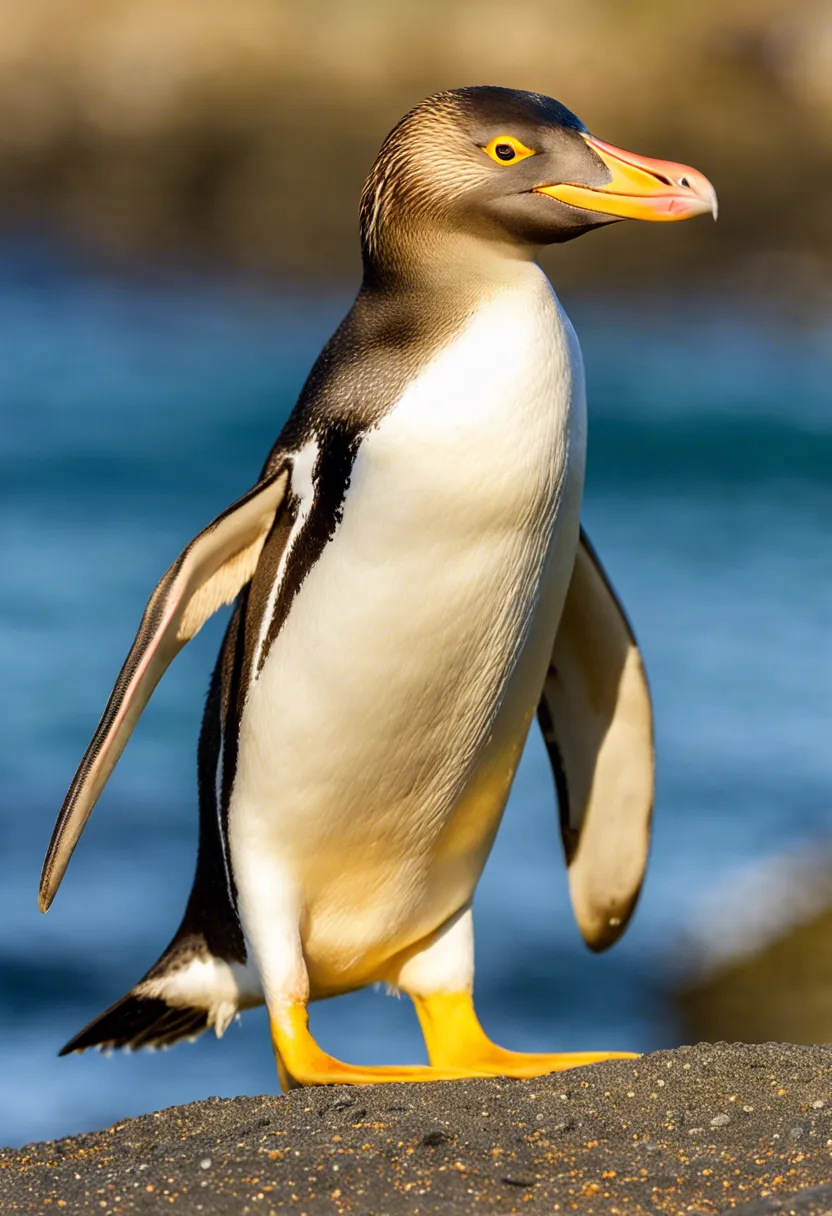Ever had a moment where you stumbled upon something so unique, it made you stop and stare? Well, that’s exactly how I felt when I first laid eyes on the “Unique and Endangered Yellow-Eyed Penguin”. These creatures are not your average penguins; they’re like the hipsters of the penguin world – distinctive, rare, and oh-so-cool in their own peculiar way.
But here’s the kicker: their uniqueness is also what puts them in danger. It’s a bit like being too popular at school – everyone wants a piece of you, but not always for the right reasons. So stick around, folks! We’re about to dive deep into the world of these cool yet critically endangered birds. “Keep reading about The Unique and Endangered Yellow-Eyed Penguin.”
Key Takeaways
- The Yellow-Eyed Penguin is a unique species native to New Zealand, currently facing the threat of extinction.
- Major threats include habitat destruction, climate change, and predation by invasive species.
- Conservation efforts are underway, including habitat restoration and predator control programs.
- Public awareness and support are crucial for the survival of this endangered species.

What is the Yellow-Eyed Penguin?
The Unique and Endangered Yellow-Eyed Penguin, scientifically known as Megadyptes antipodes, is a charming member of New Zealand’s wildlife. It’s one of those endangered penguins that are as captivating as they are rare. This penguin species has some unique features that set it apart from its tuxedo-clad cousins.
Description and Characteristics
Now, let’s talk about what makes this bird so special. First off, their eyes! The yellow-eyed penguin gets its name from its distinctive peepers – bright yellow irises that could give the sun a run for its money. But it’s not just the eyes that make them stand out in the crowd of penguin plumage coloration.
This seabird also sports a headband of yellow feathers that stretch from eye to eye across the back of its head. It’s like they’re always ready for an 80s workout video! And if you’re into wildlife identification tips, remember this: these fellas are medium-sized, standing about 65 cm tall and weighing around 5-6 kg.
Habitat and Distribution
When it comes to their stomping grounds, these birds prefer the scenic coastal areas of New Zealand and subantarctic islands. They’re real beach bums at heart! They love hanging out in forests near the coast too – talk about loving nature!
But here’s where things get tricky: their distribution is pretty limited. These birds are mostly found on the southeast coast of South Island, Stewart Island, and Auckland Islands. So if you’re planning to spot one in person, you might need to book a flight to New Zealand!
Their specific habitat preferences make endangered species habitat conservation crucial for their survival. After all, preserving our planet’s biodiversity starts with protecting our wildlife geographical distribution. Let’s hope we can keep these yellow-eyed beauties around for generations to come!
Why is the Yellow-Eyed Penguin Unique?
The Unique and Endangered Yellow-Eyed Penguin is a fascinating creature, with characteristics that set it apart from its penguin brethren. Its behavioral traits and physical features are distinct, making it a species of great conservation importance.
Unique Behavioral Traits
One thing that makes the yellow-eyed penguin stand out is its solitary behavior. Unlike other penguins who love to huddle together in large groups, these guys prefer their own company. They’re the introverts of the penguin world, if you will.
Their foraging habits are also unique. Instead of diving deep into the ocean for food like most penguins, they prefer to stay close to the surface and catch small fish and squid. It’s like they’ve decided to be gourmet eaters instead of going for the buffet option!
And let’s not forget about their breeding patterns and nesting sites. These birds are quite picky when it comes to choosing a mate and setting up home. They often return to their birthplace to breed and create nests hidden away in forests or scrubland – talk about being homebodies!
Distinctive Physical Features
Now onto their looks – these aren’t your average black-and-white tuxedo-wearing birds! The most striking feature of the Unique and Endangered Yellow-Eyed Penguin is, well, its yellow eyes. The significance of this eye color isn’t fully understood yet, but it sure does make them easy to spot!
In terms of size comparison with other species, they’re on the larger side – standing tall at around 65cm (that’s over 2 feet!). Their feather pattern is also unique with a pale yellow band wrapping around their eyes extending to the back of their heads.
And as if all these weren’t enough to differentiate them from other species, they also have morphological differences like longer flippers and a more upright stance. These identification markers make them stand out in the penguin crowd, highlighting their uniqueness and importance in the world of conservation.

What are the Threats to the Unique and Endangered Yellow-Eyed Penguin?

The threats facing our feathered friends, the yellow-eyed penguins, are as diverse as they are dire. From natural predators to human activities and even climate change, these factors all contribute significantly to their endangered status.
Natural Predators
When it comes to penguin natural enemies, yellow-eyed penguins have a rough deal. They face threats from both marine and terrestrial predators. In the sea, seals and sharks pose a significant risk, while on land, stoats and ferrets can be deadly.
Changes in predator-prey dynamics have also exacerbated these threats. For instance, an increase in seal populations due to conservation efforts ironically leads to more predation of yellow-eyed penguins. It’s a tough world out there for these birds!
Human Activities and Impact
Humans aren’t exactly helping either. Our activities pose serious risks to these critters. Overfishing depletes their food sources while pollution contaminates their habitats.
Habitat destruction is another biggie. As we develop coastal areas for human use, we’re leaving less space for our flippered friends. But hey, it’s not all doom and gloom! Conservation efforts are underway to protect the yellow-eyed penguin from further decline.
Climate Change Effects
Climate change is another major player in this sad saga. Changes in temperature mess with penguin habitats and food sources – not cool! Global warming affects marine ecosystems which directly impacts the survival of our yellow-eyed pals.
Food scarcity is becoming a real issue too as fish populations shift due to warmer waters. Researchers predict that if things don’t change soon, the future could look pretty bleak for this unique species. But let’s keep our flippers crossed that it doesn’t come to that!
What is the Conservation Status of the Unique and Endangered Yellow-Eyed Penguin?
The conservation status of our feathery friend, the yellow-eyed penguin, is a bit of a mixed bag. It’s currently listed as an endangered species, with population decline being a major concern. But don’t lose hope just yet! There are numerous wildlife protection initiatives and habitat restoration projects in place to help these adorable waddlers bounce back.
Current Population Trends
Let’s talk numbers, shall we? Recent studies paint a somewhat gloomy picture for the yellow-eyed penguin population. We’re seeing declining numbers across the board due to various factors. Environmental impact on species plays a big role here, with climate change being one sneaky culprit.
But it’s not all doom and gloom! Some areas have reported stable or even increasing breeding success rates. That’s right – our little penguins are still doing their best to keep their species alive and kicking!
And let’s not forget about human impact. Our activities can sometimes pose threats to these critters. From pollution to habitat destruction, we humans need to check ourselves before we wreck more than just ourselves.
Conservation Efforts and Initiatives
Now onto some positive news – there are plenty of conservation programs working tirelessly to protect our yellow-eyed penguin pals. Habitat protection measures are in full swing, with efforts focused on restoring their natural environments.
Anti-predation strategies also play a crucial role in keeping these birds safe from harm. Predator control isn’t just about removing threats; it’s also about educating communities on how they can help.
Speaking of communities, local involvement in conservation activities has been phenomenal! From wildlife rehabilitation to public awareness campaigns, people are stepping up for our feathered friends. And that my friends, gives us hope for the future of this unique and endangered bird.
How Can We Help Protect the Yellow-Eyed Penguin?
So, you’re asking, “How can we help our feathered friends, the unique and endangered yellow-eyed penguin?” Well, there are a couple of ways to go about it. Let’s start by talking about supporting conservation organizations.
Supporting Conservation Organizations
Ever heard of conservation group support? It’s a big deal in the world of wildlife protection. These groups are on the front lines, fighting for our flippered pals every day. They rely heavily on wildlife protection donations and volunteers to keep their operations running.
You might be thinking, “I’m just one person. What difference can I make?” But let me tell you something: every little bit helps! Your donation could fund vital research or habitat restoration projects. And if you’ve got some spare time on your hands, why not volunteer for penguins?
It’s not just about money or time either; raising awareness is crucial too. Sharing information about these organizations and their work can encourage others to get involved. Remember, we’re all in this together to protect endangered species, especially our friend the yellow-eyed penguin!
Responsible Tourism Practices
Now let’s talk tourism – but not just any kind of tourism. We’re talking eco-friendly, sustainable tourism that respects wildlife and their habitats.
Visiting places where yellow-eyed penguins live can be an incredible experience. But it’s important to remember that we’re guests in their home. This means following certain guidelines to minimize our impact on nature.
First off, always keep your distance from these birds – no matter how cute they may be! Disturbing them can stress them out and disrupt their natural behavior.
And don’t forget to stick to designated paths when exploring their habitats. This helps protect delicate ecosystems from human interference.
By following these simple yet effective responsible visitor guidelines, we can ensure that our tourism practices are sustainable and respectful. So next time you’re planning a trip, remember: be a responsible tourist, not just for the yellow-eyed penguin conservation, but for all wildlife out there!

To Wrap Up
So, we’ve journeyed through the life of the Unique and Endangered Yellow-Eyed Penguin, a bird that’s as rare as a unicorn at a donkey party. They’re truly one-of-a-kind, but their numbers are dwindling like ice-cream on a hot day.
Let’s not let these intriguing creatures become just a legend like Bigfoot. It’s time to step up, raise awareness and ensure their survival story continues. After all, who doesn’t love a good comeback tale?


